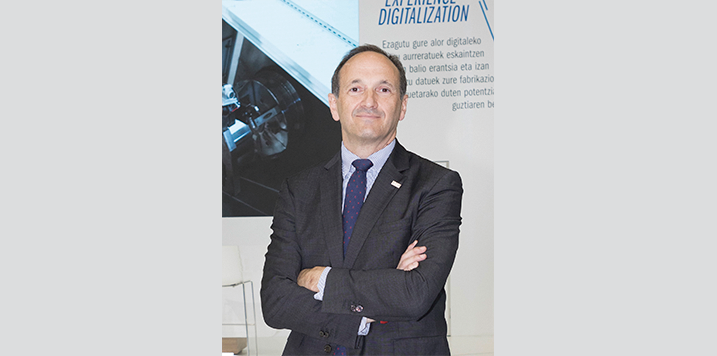 16 February, 2021
16 February, 2021The advanced manufacturing technology and machine tools sector has released provisional data for 2020 that show a drop of 21.4% in turnover, with a somewhat greater drop in exports of 22.4%. The tremendous difficulties and the uncertainty caused by the pandemic have led to a significant fall in demand due to the temporary closure of some strategic markets and the impossibility of travelling to attend to sales, installations and maintenance.
Despite all the difficulties, the recuperation experienced in the fourth quarter of the year has significantly improved the situation, allowing the new year to be viewed with renewed optimism.
The impact has been general across all sub-sectors of activity, although metal forming sub-sector (which had already suffered during the two preceding years) showed the most severe losses. The metal cutting sub-sector had slightly better figures, particularly milling machines, components and cutting tools.
EXPORTS
In 2020, the main countries for exports were: Germany, with a 12.1% share, USA, with 10%, France, with 9.7%, Italy, with 7.4%, and China, with 7%. Following these were Mexico (5.8%), India (5.2%), Portugal (5.1%), the UK (3.8%) and Turkey (2.7%), practically the same destinations as in 2019.
In this regard, it is important to note that, unlike exports (which are the result of orders received months earlier), the orders received during 2020 have changed strongly. China has been the first and most active country to relaunch its industrial activity, and as a result is leading in new orders, ahead of Germany, with Spain in third place. These countries are followed by the USA, Turkey, France, Italy and India.
In the words of AFM Chairman, César Garbalena: “For an essentially export sector like ours, it is vital right now to return to normality in the markets and in professional visits for sales, installation and maintenance of manufacturing equipment.”
DOMESTIC MARKET
Spain has seen a new fall-off in investment in machine tools. On the one side, the Spanish manufacturers’ sales to the domestic market have dropped in a very similar way to the exports markets drop (-18.3%) after a bad year in 2019. On the other side, consumption (production + imports – exports) has suffered the most, losing over 30% compared to 2019, which indicates a continuing process of reduction of industrial capitalisation.
Garbalena insists in the importance of having the latest equipment and applauds the recently-announced “National Renewal Plan”: “Investing in highly-digitalised and automated equipment and undertaking the renovation and upgrading of machinery is an urgent necessity and a great opportunity to transform the Spanish productive model. For this, we need to manufacture products with greater added value and technological complexity, and to increase sales of advanced digital industrial services.
After a decade of determined support for investment in machinery by the Basque administration, from AFM we applaud and appreciate the commitment of those who have agreed to provide a budget of 50 million euros for the first National Machine Tool Renewal Plan. The urgent implementation of this program within the first quarter could push the demand, really in need of a strong boost.”
ORDERS
The volume of orders received in 2020 fell off with respect to 2019 by 23.5%. In this respect, the Spanish market suffered less (-12.11%), while the export market suffered much more (-24.93%). On the other hand, just as in the last three years, the metal forming sub-sector saw the most significant losses, exacerbated by the unresolved crisis of the automotive sector, while metal cutting suffered less, given its multi-sectoral position.
The pandemic has affected the client sectors to different extents, with the air transport sector especially affected, leading to the paralysis of new programs, which has slowed down investment. The automotive sector managed to increase its activities in the second half of the year, but has nevertheless reduced its investments, affecting the demand for large presses, already affected by two complicated years.
At the other end of the spectrum, the energy sector, ICTs and the food and agriculture industry are showing more positive tendencies.
2021, A STRONG DRIVE TOWARDS DIGITALISATION IN THIS INDUSTRY
The new year is starting with conflicting feelings and the need for markets to return to normal and to reactivate.
Everything indicates that 2021 will be the first year of recuperation, and we must face it optimistically, even though the start of the year has been marred by the uncertainty caused by the realities of vaccinations in Europe. We expect the first quarter to be the most difficult, and that things will gradually improve as the year goes on. In this regard, the orders received towards the end of last year are important, since they provide a respite to continue operating until activities and demand pick up. Nevertheless, it seems that the sector will have to wait until 2022 to really get back to normal.
Referring to the eagerly-awaited recuperation, the AFM president remarked: “The NEXT GENERATION EU funds should aid in all aspects of the recovery of the European economy, especially in industry, the real source of innovation, internationalisation and welfare. To this end, we must undertake ambitious, transformative projects in which SMEs can participate, providing abundant resources for the different programs from State and Regional administrations to promote digitalisation and the sustainability of the manufacturing industry. Along these lines, AFM has coordinated the launch of a ground-breaking transformation project for advanced manufacturing named “e-machine Digital Workshop”, in which we are seeking support to invest 245 million Euros to take us into a leading position in advanced digital products and services for industry.
In addition, we consider that we are approaching a unique opportunity to recuperate the sadly reduced support of ICEX regarding digitalisation of this industry, and so increase, via CDTI, the ratio of non-returnable financing of R&D&i in national and international projects, allowing an increase in the percentage of GNP invested in Spain in research, development and innovation activities.”
Subscribe to our newsletter. Just insert your e-mail and you will receive the latest news.